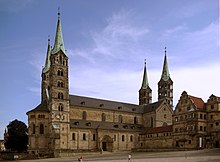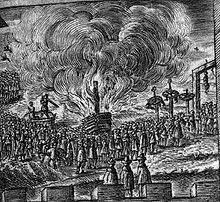
Back Judici de les bruixes de Bamberg Catalan Hexenverfolgung in Bamberg German Juicio de las brujas de Bamberg Spanish משפטי הכישוף בבמברג HE バンベルク魔女裁判 Japanese Julgamento das bruxas de Bamberg Portuguese Häxprocessen i Bamberg Swedish




The Bamberg witch trials of 1627–1632, which took place in the self-governing Catholic Prince-Bishopric of Bamberg in the Holy Roman Empire in present-day Germany, is one of the biggest mass trials and mass executions ever seen in Europe, and one of the biggest witch trials in history.
Over an extended period around 1,000 people were executed after being accused of witchcraft in Bamberg, about 900 of whom were executed in 1626–1632.[1] People of all ages, sexes and classes, all of whom were burned at the stake, sometimes after having been beheaded, sometimes alive. The witch trials took place during the ongoing religious Thirty Years' War between Protestants and Catholics, in an area on the religious border between Catholic and Protestant territories, and were conducted by a Catholic Prince Bishop intent on introducing the Counter-Reformation in his territory.
The Bamberg witch trials are among the largest Witch trials in the Early Modern period: it was one of the four largest witch trials in Germany alongside the Trier witch trials, the Fulda witch trials, and the contemporary Würzburg witch trials.[2]
- ^ Durrant, J.B. (2007). "Witch-hunting in Eichstätt". Witchcraft, Gender and Society in Early Modern Germany. Brill. pp. 3–44. doi:10.1163/ej.9789004160934.i-288.13. ISBN 978-90-474-2055-2. JSTOR 10.1163/j.ctt1w76wh1.7.
- ^ Midelfort, H. C. Erik (1972). Witch Hunting in Southwestern Germany, 1562-1684: The Social and Intellectual Foundations. Stanford University Press. ISBN 978-0-8047-0805-0.[page needed]
© MMXXIII Rich X Search. We shall prevail. All rights reserved. Rich X Search